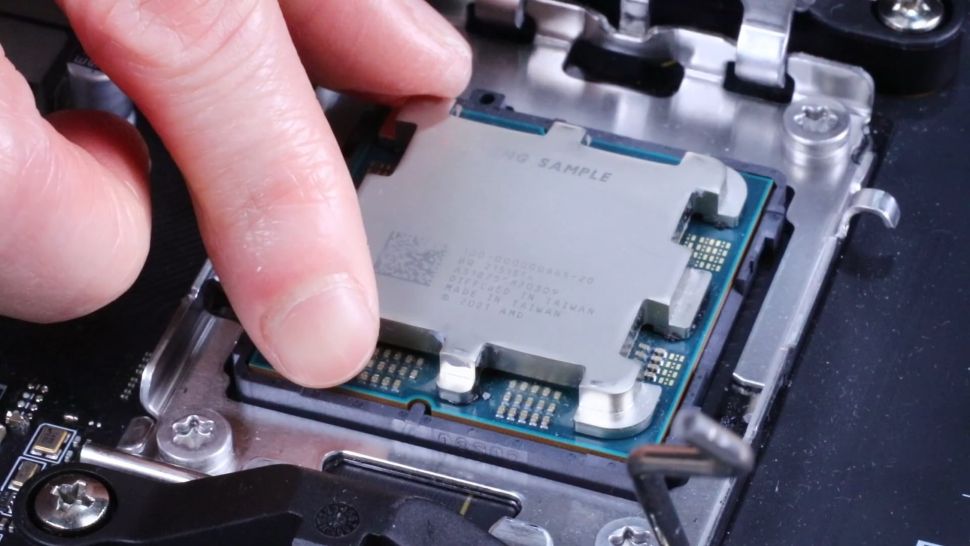At Computex 2022, AMD shared new benchmarks and details about its 5nm Zen 4 ‘Raphael’ Ryzen 7000 processors and AM5 socket motherboards, but it turns out the company made a mistake: AMD originally stated that Socket AM5 would have a 170W Package Power Tracking (PPT) limit, meaning that would be the peak amount of power the socket could feed to any given processor. However, AMD has now clarified that the original number it shared is in error, and the peak power consumption for the AM5 socket is actually 230W. That’s a significant increase over the previous-gen’s 142W limit.
This equates to a 170W TDP for some processors designed for the AM5 socket, like Ryzen 7000, a significant increase over the current 105W limit with the Ryzen 5000 processors.
AMD issued the following to Tom’s Hardware:
“AMD would like to issue a correction to the socket power and TDP limits of the upcoming AMD Socket AM5. AMD Socket AM5 supports up to a 170W TDP with a PPT up to 230W. TDP*1.35 is the standard calculation for TDP v. PPT for AMD sockets in the “Zen” era, and the new 170W TDP group is no exception (170*1.35=229.5).
“This new TDP group will enable considerably more compute performance for high core count CPUs in heavy compute workloads, which will sit alongside the 65W and 105W TDP groups that Ryzen is known for today. AMD takes great pride in providing the enthusiast community with transparent and forthright product capabilities, and we want to take this opportunity to apologize for our error and any subsequent confusion we may have caused on this topic.” — AMD Representative to Tom’s Hardware (emphasis added)
You’ll notice that AMD’s statement doesn’t specifically call out the Ryzen 7000 series, but those processors will drop into the AM5 socket, so it’s fair to assume that we will see 170W versions (EDIT: AMD has since clarified that the 170W TDP will apply to Ryzen 7000). That’s a 65W TDP and an 88W PPT increase over AMD’s current flagships. This increased power delivery will help the Ryzen processors in heavily-threaded workloads, like the Blender benchmark the company demoed during Computex that saw Ryzen 7000 thrashing Intel’s Alder Lake Core i9-12900K.
The increased 170W TDP also means that we could see souped-up 12- and 16-core Ryzen 7000 chips with a 170W TDP for extreme users, while 105W 12- and 16-core models slot in for more mainstream uses.
This new tier of 170W Ryzen chips could be AMD’s attempt to create a new quasi-HEDT tier of chips on its standard mainstream PC platforms, which would make a lot of sense given that Threadripper has largely disappeared from retail in favor of pricier Threadripper Pro models for professional users. Quad-channel memory bandwidth was one of the key reasons to jump up to a Threadripper platform, but dual-channel bandwidth from DDR5 on the AM5 platform could be potent enough for the semi-professionals and content creators that AMD targets with the standard non-Pro Threadripper lineup.
TDP and PPT can be a bit complicated. Even though TDP is a very good approximation for power consumption, it actually quantifies the needed thermal dissipation capability of the cooler to ensure the CPU can operate at the rated performance specifications. AMD expresses this value in thermal watts, not electrical watts. Confusing, right?
However, more simply put, the TDP value basically mirrors power consumption when all of the processor’s cores are under load and not in a boosted state — i.e., running at base frequency. That means you can use it as a good approximation of ‘base’ power consumption. Meanwhile, the PPT value quantifies the maximum amount of power that can be delivered to the processor, which occurs when the CPU runs at boost frequencies — i.e., running under full load but still within the thermal and power envelope that allows the processor to boost to higher-than-base frequencies.
Increasing the TDP and PPT will help AMD deliver more performance, particularly for its higher core-count models, during heavy multi-threaded workloads. In many cases, AMD’s previous limit of 142W with the previous-gen AM4 socket held back performance, so the additional 88W of power will be particularly helpful with the newer 12- and 16-core models.
AMD has specified that it will use the standard TDP and PPT calculations for chips that drop into the AM5 socket, so you can simply multiply the TDP by 1.35 to calculate the maximum power consumption of the chip (PPT). Notably, there were exceptions to that rule with Ryzen 5000 — some chips, like the 65W Ryzen 5 5600X, use a 1.17x ratio (the 5600X’s PPT was 76W). For now, it doesn’t appear that will apply to Ryzen 7000. But enough with the little details.
We know that Ryzen 7000’s 5nm process will deliver more performance-per-watt than the 7nm process that AMD used with Ryzen 5000 — TSMC says the 5nm process uses either 30% less power or delivers 15% more performance than 7nm (you can’t have both at once, though, this is a sliding scale). So that means that we should expect significantly more performance-per-watt from 5nm chips.
Still, even with that additional headroom, AMD has also chosen to increase the power limit as it continues to vie for supremacy in CPU benchmarks and the best CPUs for gaming against Intel’s finest. Intel itself has surely pushed power consumption to the extreme over the last several generations of its own chips: Intel’s Core i9-12900KS represents its highest TDP for a mainstream processor that we’ve ever seen at 150W, but AMD’s 170W eclipses that. However, the 12900KS has a 241W peak power rating, while Ryzen 7000 could top out at 230W. Even with the architectural and process node enhancements that AMD has made with Zen 4, it’s clear that it will also turn up the dial on power consumption as it attempts to maintain the lead. Ryzen 7000 comes to market in Fall 2022.

